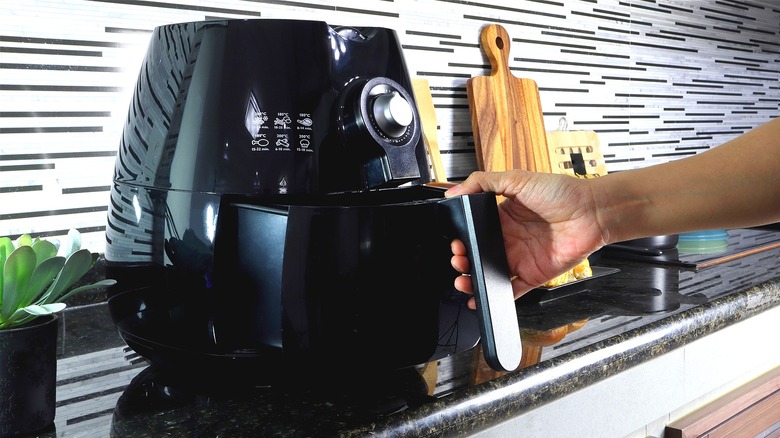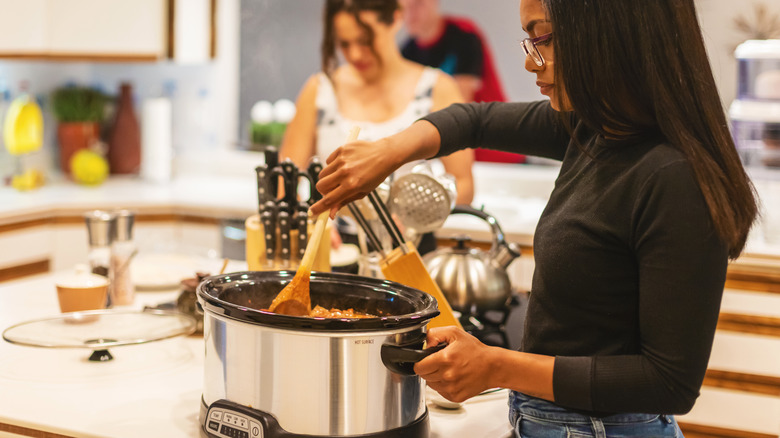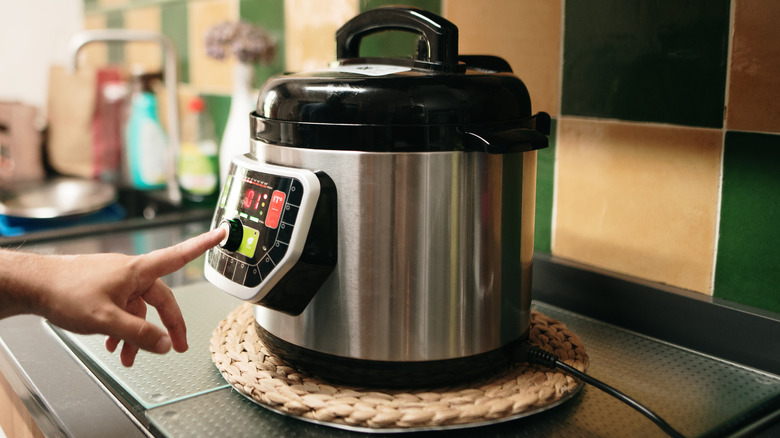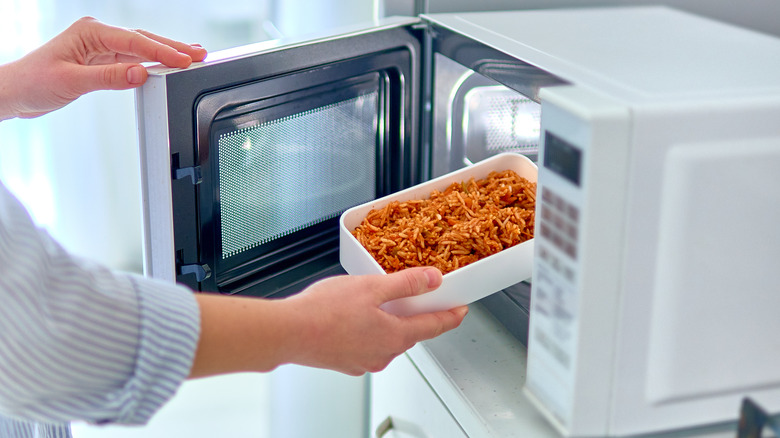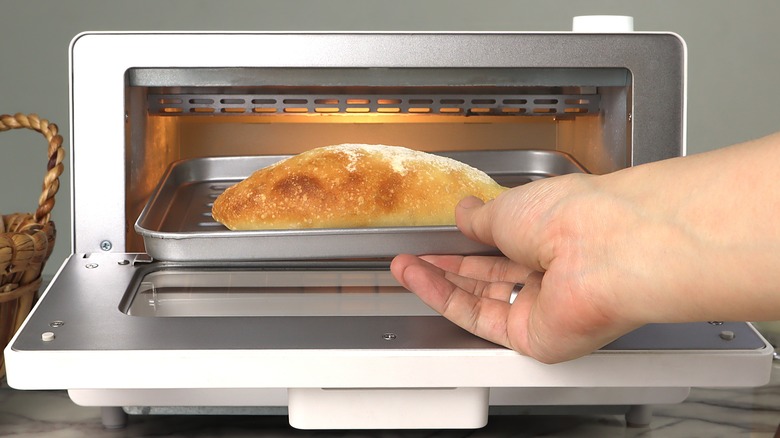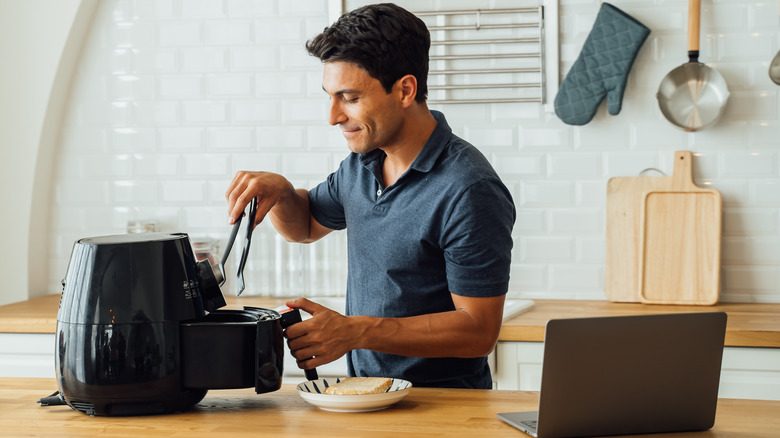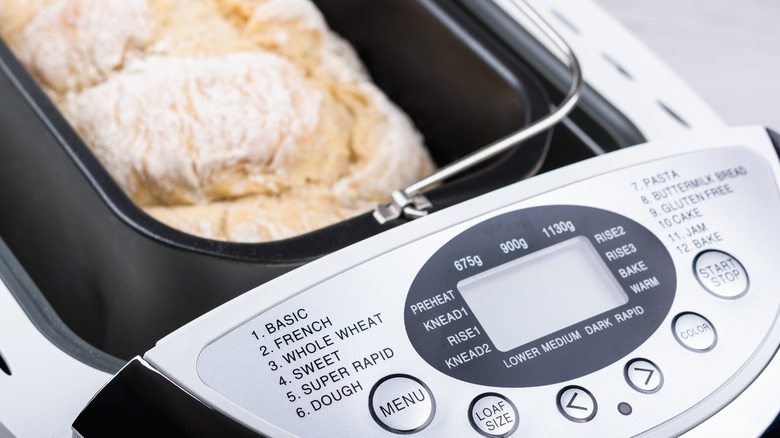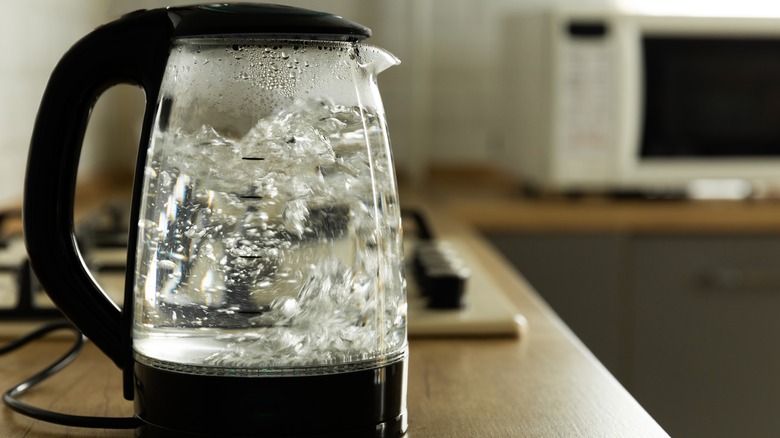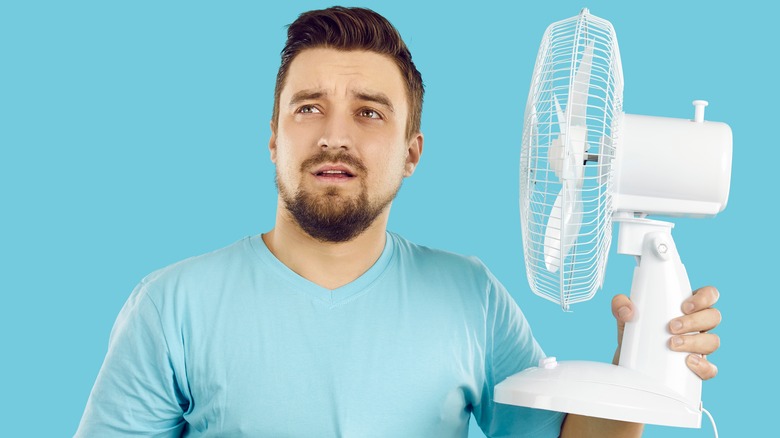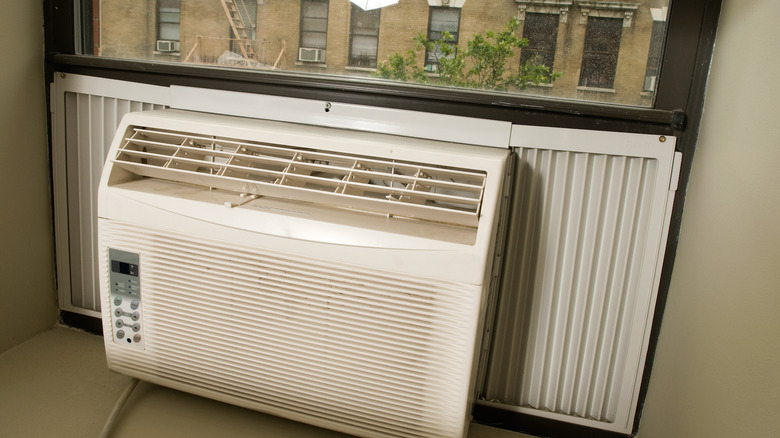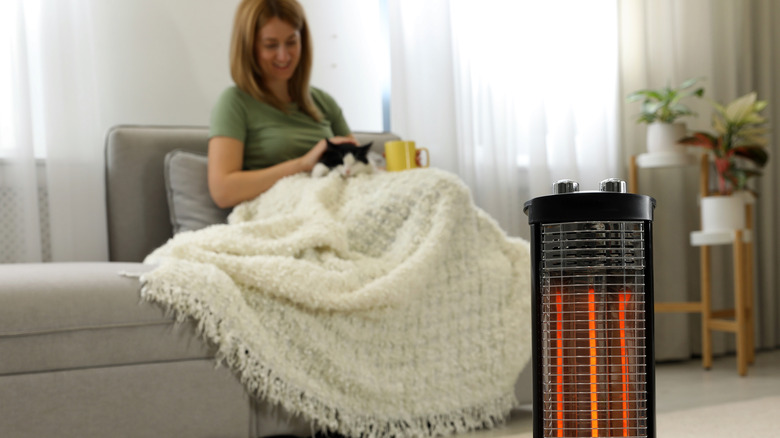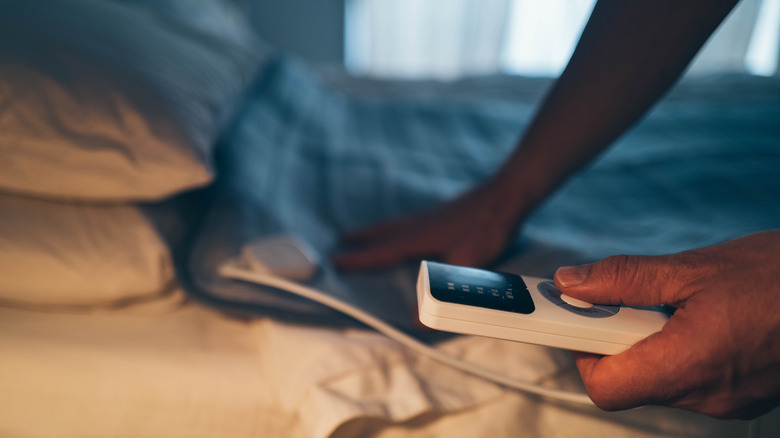11 Small Appliances That Will Help Slash Your Power Bill
There are quite a few tips and tricks you can implement when you're looking to cut down your electricity expenses, including reducing your dependence on large appliances that use a lot of energy and changing some of your kitchen habits. Using small appliances in your kitchen can help reduce the amount of cooking-related electricity you use daily. For example, suppose you're in the habit of cooking most of your meals on the stovetop or in your full-size oven. In that case, you might be surprised to learn that transitioning some of your meal preparation tasks to small appliances can help you cut back on how much energy you use for cooking.
Kitchen small appliances aren't the only electric gadgets that can help you save money on your utility bills. Incorporating small appliances into other aspects of your household routine can play a big role in helping to slash your power bill, so power savings from small appliances don't have to be limited to kitchen-related energy usage. Strategically using small appliances in other areas of your home can also help you save money on your electricity bill and other utilities.
Consider the small appliances listed below and consider how to incorporate them into your household habits. The more devices like these become integrated into your regular routine, the more you'll be able to save.
Slow cooker
Slow cookers are a great way to cook delicious meals while minimizing the energy-related cost of cooking. This is especially true when cooking dishes that take a long time to cook on a traditional stovetop or in a regular oven. That's because of the cost it takes to operate each appliance as well as how long it takes to cook whatever dish you are preparing.
A traditional electric oven costs a little over 50 cents per hour to operate, while a slow cooker costs only about five cents to use for the same length of time. It can take around four hours to cook a three- to four-pound pot roast in an oven, so cooking a roast this way will add a little over $2 to your energy bill. It'll probably take six to eight hours to cook the same roast in a slow cooker, a task that'll use no more than 40 cents worth of electricity.
It's also possible to cook a pot roast on a stove in about the same length of time it would take in an oven, but this method will still use more energy than a slow cooker. An electric stove costs just over 35 cents per hour to use, so it's going to cost less to cook a pot roast this way than in an oven, but more than in a slow cooker.
Electric pressure cooker
An electric pressure cooker is also a great way to cook delicious meals in an energy-efficient manner. Not only does this type of appliance use less energy per hour to operate than a regular stove or oven, but (unlike a slow cooker), it can also reduce the amount of time it takes to prepare dishes that otherwise take a long time to cook.
For example, it costs around 17 cents per hour to operate an Instant Pot and you can cook a three- to five-pound pot roast in this type of appliance in two hours or less. Even at the longest cooking time, this adds up to using just 34 cents of electricity to cook a delicious, hearty dinner. Even though the hourly rate for an electric pressure cooker is higher than that of a slow cooker, the faster cooking time means that the pressure cooker can be used to prep a meal with even less energy usage than a slow cooker.
You can keep the cost of cooking items in an electric pressure cooker to the bare minimum by timing your cooking so the food is ready just before you're ready to serve it. This will keep you from needing to operate the "keep warm" function once cooking is complete. It's also a good idea to unplug this gadget when not in use, as well as any other small appliances that draw phantom power.
Microwave
Costing only about 20 cents per hour to operate, microwave ovens use far less energy than full-size ovens. This is less than either a gas or electric oven, as a full-size gas oven uses about 40 cents worth of gas per hour, and, as stated above, a traditional electric oven costs just over 50 cents per hour to operate. That's why it's a good idea to look for ways to utilize a microwave instead of a regular oven when it makes sense to do so, especially if you're looking to minimize your power or gas bill.
Microwaves are a great option for reheating leftovers, but that's not all they're for. Microwaves can also be used to cook some meals or side dishes, especially when you only need to make a few servings. You could cook a side dish – such as corn on the cob – in the microwave to go with a pot roast prepared in your slow cooker or electric pressure cooker and still use less power than if you cooked both items in your traditional oven at the same time. For more ideas, explore this list of things you didn't know you could cook in a microwave.
Of course, not everything should be cooked in a microwave. To prevent wasting groceries, avoid using this type of small appliance with eggs, anything packaged in single-use plastic, or most takeout containers.
Toaster oven
Just like microwave ovens can be used for more than just reheating leftovers, toaster ovens aren't limited to toast-making. Toaster ovens vary greatly in size, which can impact their operating cost, but they don't pull nearly as much energy as a full-size oven or a stovetop to operate. A toaster oven can be a great small appliance option for cooking small meals or side dishes, including items that won't do well in a microwave. You can even use this type of gadget for very small-batch baking. Baking a cake in a toaster oven is surprisingly easy to do.
Keep on using your toaster oven to make toast, but don't stop there. For more ideas on how to incorporate your toaster oven into everyday cooking, explore Money Digets's collection of toaster oven creations that make dinner time easy. Of course, not everything can be cooked in a microwave. Take the time to learn about foods you should never cook in a toaster oven to make sure you don't end up wasting ingredients as a result of your efforts to reduce your energy expenses by using small appliances.
Air fryer
Air fryers are a trendy and fun way to prepare tasty treats and meals, but they can also help you cut your cooking-related energy expenditures. Air fryers are a great small appliance to use when you're on a quest to cut your cooking-related power bill. That's because air fryers cost just 20 cents per hour to operate, which is half the cost of operating a gas oven and less than half the cost of using one that's electric. Plus, air fryers cook items faster than a regular oven, so you won't have to run your air fryer as long as a traditional oven to cook the same item.
Do you like the idea of increasing your air fryer usage as a way to decrease your power bill, but aren't sure how to get started? It's easier than you might think. There are a lot of great air fryer recipes and tips you can use to master this uber-cool small appliance. Start by building out your next meal plan around the best meats to cook in an air fryer and complete your menu with some of these unique things to make in an air fryer.
Bread machine
Do you love the taste of homemade bread so much that you make your own? If so, you might be a bit surprised to learn that using a bread maker for some (maybe all) of your baking may be able to help you cut back on your cooking-related energy bill. This isn't true for everyone, as it depends on how many loaves of bread you bake at the same time.
According to Edison International, using a bread maker will help you save energy if you're in the habit of baking just one loaf of bread at a time. However, if you tend to bake multiple loaves at the same time, your traditional oven will probably be the most economical option, energy-wise.
Why does the number of loaves matter? As with all small appliances, bread machines have a limited capacity. A bread machine can only bake a single loaf at one time. By the time you run a bread machine multiple times, you'll most likely use as much (or more) energy than you would using your regular oven.
Electric tea kettle
Did you know that electric kettles aren't just for making hot tea? When you need hot water, using an electric tea kettle to heat the water is actually more cost-effective and energy-efficient than turning on the tap and letting the water run while you wait for it to get hot. After all, when you run water in your sink long enough to let it heat up, you're driving up your water bill and wasting water, as well as using electricity or gas to heat the water. With an electric tea kettle, you can just add the amount of tap water you need to the container and push a button to turn it on.
With an electric kettle, there's no need to let the water run to change the temperature, so there's no waste. If you need to heat water but not boil it, simply let the electric kettle do its thing for a few minutes and then turn it off for maximum energy efficiency. Or, if you're making tea or need boiling water for another purpose, such as mixing up just-add-water meals, you can just let the kettle run until it turns off automatically. Because electric tea kettles automatically turn off as soon as they start to boil, you won't end up using more energy than necessary or creating a hot mess due to boiling over, both of which can easily happen when using a stovetop to boil water.
Electric fan
Looking for a way to stay cool on the cheap? An electric fan just might do the trick. Electric fans cost just a penny per hour to operate. This is a whole lot cheaper than a central air conditioning unit, which costs about 45 cents per hour to operate, or a window or wall unit, which has an operating cost of about 11 cents per hour. With such low energy usage, electric fans are small but mighty gadgets that can make a big difference in your comfort level — and the size of your power bill — when the temperature is on the rise.
Now, you shouldn't rely solely on fans to cool your entire living space in a heat wave. However, supplementing an air conditioner with fans can help you stay comfortable without having to turn the thermostat down so low that the A/C has to run almost nonstop. The less time the A/C runs, the less energy it will use. Simply set your air conditioner a few degrees higher than you truly prefer, then place a fan so that it's blowing directly on you to cool yourself down a bit more. Since fans are portable, you can easily move them around as you go from room to room at different times of day.
Window or wall unit air conditioner
Window unit air conditioners can also be a cost-efficient way to keep specific rooms cool when it's hot outside, as can wall units (which serve the same purpose but don't have to be installed in a window). Window or wall cooling units can be an alternative to central air conditioning, or they can be used to strategically supplement a central unit. After all, it does cost about 25% less per hour to operate this type of cooling unit than a central air conditioner.
Window or wall units are a particularly good supplemental air conditioning option for sunrooms, which tend to get quite a bit hotter than other rooms that don't get as much direct sunlight. They can also be great additions to the bedrooms of family members or roommates who like to sleep in very cold temperatures. Rather than using more expensive central air to cool the house down to the level they like, which may cause everyone else to have to bundle up, a window or wall unit can be a great solution. Simply use the central A/C to get the house to a level that's comfortable for most people, then let the folks who like to sleep in an uber-cold room rely on a window or wall A/C — maybe paired with a fan or two — to cool things down even further.
Space heater
Just like small air conditioners and fans are a great way to supplement a central air conditioner, space heaters also provide an energy-efficient way to stay toasty and warm while minimizing the use of your whole house heating system. This can result in significant cost savings, as space heaters cost about 23 cents per hour to operate, while heat pumps and electric furnaces cost over $1.50 per hour.
Space heaters can help you delay when you start using your central heating system, as placing a space heater in your bedroom can be enough to keep you warm when the temperatures first start to dip in the fall. They can also help you manage heating expenses once the temperature turns really cold. For example, by selectively using space heaters in certain rooms only when they're occupied or placing them near particularly cold-natured residents or guests, you'll be able to stay comfortable without having to keep the thermostat turned up to an ideal temperature. Keeping the thermostat lower will reduce the amount of time the central heating has to run, which can help keep your bill lower than it would otherwise be.
Electric blanket
Using an electric blanket at night is another great way to minimize the use of a central heating system and/or space heaters during the coldest months of the year, a choice that can result in significant savings on your energy bill. Using a king-size electric blanket costs just 15 cents per night (not per hour), and smaller ones cost even less to use.
Sleeping under an electric blanket means that you can turn the thermostat down when it's time to curl up under the covers, yet stay toasty and warm at a temperature customized to your preference. Because electric blankets help keep you comfortable while reducing the amount of time you need to use more expensive heating options, they provide an energy-efficient way to stay toasty and warm when it's cold outside.
Note: Electric blankets are not recommended for young children, individuals with significant mobility impairments, people who have problems sensing heat, or those who are not capable of understanding how to safely operate this type of device.
